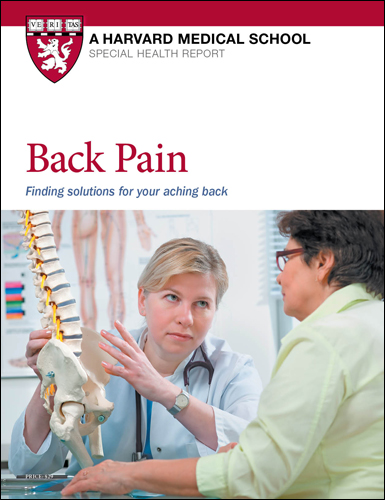Create a plan to relieve your back pain

At some point in life, odds are good that you’ll experience back pain: four out of five Americans do. Aches, stiffness, muscles spasms, and trouble tackling minor or major tasks may slow you down considerably.
While the cause is rarely life-threatening, the pain can be debilitating. If back pain is recurrent or chronic –– that is, lasting longer than 12 weeks –– seeking good care is essential.
The scientific evidence for different treatments is not always cut-and-dried, but here are five steps you can take to get the best results:
- Get an accurate diagnosis of your back disorder. This requires a physical exam and possibly imaging scans, such as x-rays, an MRI, or a CT scan. Blood tests and nerve testing may also be recommended. An accurate diagnosis allows you to choose among the treatment options proven to work best for your specific back problem.
- Seek an experienced, certified, and well-recommended health professional who understands your type of back problem. For example, this may mean a licensed physical therapist, a physiatrist specializing in physical medicine and rehabilitation, or a board-certified neurologist or orthopedic surgeon.
- Be an active participant in your care. Shared decision making in health care means fully understanding the risks and benefits of each treatment you are considering. Be sure to ask about your full range of options––and what will happen if you decided not to treat the problem.
- Explore non-drug therapies first, such as physical therapy, exercise, and mind-body practices like yoga or tai chi. These approaches are often effective, carry fewer risks than medications or surgery, and can help you build long-term resilience against back pain.
- Don’t be afraid to request a second opinion if your clinician recommends an invasive, experimental, or very expensive treatment. Doctors generally welcome your full participation in health care decisions and should support your request for a second opinion if you feel hesitant about a particular option.
Treating and preventing persistent or recurrent back pain
The specific therapeutic approach depends on your diagnosis. But many people find significant relief for their chronic or recurrent back pain using one or more of these non-invasive approaches:
- Physical therapy that includes supervised exercise is often a first-line approach. The goals are to help strengthen the muscles that support the spine, improve flexibility, and promote better posture.
- Mind-body practices like yoga, tai chi, and mindfulness-based stress reduction may also ease pain and improve your ability to function, especially when combined with other therapies. These options are generally safe, have few side effects, and empower people to play an active role in their recovery.
- Medications, such as NSAIDS, muscle relaxants, and drugs to relieve nerve pain. Often, medications are combined with physical therapy or mind-body practices.
- Lifestyle factors play a crucial role in managing back pain. In fact, they can help lessen your reliance on medications while offering you greater control over your symptoms. Staying physically active, avoiding prolonged sitting, maintaining a healthy weight, and practicing stress reduction techniques can help reduce flare-ups and prevent long-term disability. Evidence suggests that people who engage in regular activity and make positive changes like these tend to have better outcomes than those who rely solely on medications or passive treatments like rest or massage.
Managing back pain can be challenging, but taking an active, informed approach puts you in the best position for long-term relief. By seeking the right diagnosis, working closely with knowledgeable health professionals, and embracing evidence-based treatments and healthy lifestyle habits, you can reduce pain, improve function, and regain your quality of life.
Remember, you don’t have to navigate this journey alone — support and effective options are available to help you move forward with confidence. With the right tools and mindset, lasting relief is within reach.
For more on healing an aching back, review Back Pain, a Special Health Report from Harvard Medical School.
Image: © gilaxia/Getty Images
Disclaimer:
As a service to our readers, Harvard Health Publishing provides access to our library of archived content. Please note the date of last review or update on all articles.
No content on this site, regardless of date, should ever be used as a substitute for direct medical advice from your doctor or other qualified clinician.
















